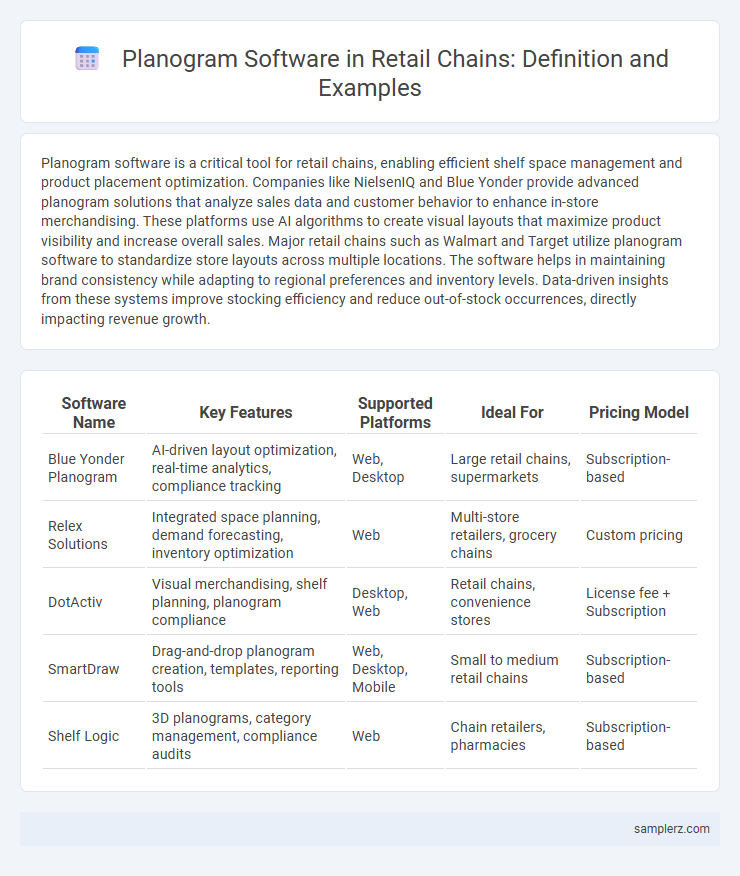Planogram software is a critical tool for retail chains, enabling efficient shelf space management and product placement optimization. Companies like NielsenIQ and Blue Yonder provide advanced planogram solutions that analyze sales data and customer behavior to enhance in-store merchandising. These platforms use AI algorithms to create visual layouts that maximize product visibility and increase overall sales. Major retail chains such as Walmart and Target utilize planogram software to standardize store layouts across multiple locations. The software helps in maintaining brand consistency while adapting to regional preferences and inventory levels. Data-driven insights from these systems improve stocking efficiency and reduce out-of-stock occurrences, directly impacting revenue growth.
Table of Comparison
| Software Name | Key Features | Supported Platforms | Ideal For | Pricing Model |
|---|---|---|---|---|
| Blue Yonder Planogram | AI-driven layout optimization, real-time analytics, compliance tracking | Web, Desktop | Large retail chains, supermarkets | Subscription-based |
| Relex Solutions | Integrated space planning, demand forecasting, inventory optimization | Web | Multi-store retailers, grocery chains | Custom pricing |
| DotActiv | Visual merchandising, shelf planning, planogram compliance | Desktop, Web | Retail chains, convenience stores | License fee + Subscription |
| SmartDraw | Drag-and-drop planogram creation, templates, reporting tools | Web, Desktop, Mobile | Small to medium retail chains | Subscription-based |
| Shelf Logic | 3D planograms, category management, compliance audits | Web | Chain retailers, pharmacies | Subscription-based |
Top Planogram Software Solutions for Retail Chains
Top planogram software solutions for retail chains include Blue Yonder, DotActiv, and Nielsen Spaceman, known for their advanced shelf space optimization and inventory management capabilities. These platforms leverage AI-driven analytics to enhance product placement, boost sales, and improve customer experience across multiple store locations. Integration with POS systems and real-time data updates ensure consistent execution of merchandising strategies across retail chains.
Key Features of Leading Planogram Tools
Leading planogram software in retail chains offers advanced shelf visualization, real-time inventory integration, and customizable layout templates to optimize store displays. These tools utilize AI-driven analytics to maximize product placement efficiency and enhance customer experience. Integration with POS systems enables seamless tracking of sales impact and inventory turnover.
How Planogram Software Streamlines Chain Store Operations
Planogram software such as BlueYonder and JDA Software play a crucial role in streamlining operations across chain stores by automating shelf space allocation and inventory management. These tools optimize product placement based on sales data and customer behavior, enhancing visual merchandising and reducing out-of-stock occurrences. Integration with POS systems and real-time analytics enables efficient planogram compliance monitoring, leading to improved sales performance and operational consistency throughout the retail chain.
Popular Planogram Platforms Used by Major Retail Chains
Popular planogram platforms used by major retail chains include Blue Yonder, JDA Software, and Nielsen Spaceman, which offer advanced features for shelf space optimization and inventory management. These software solutions leverage AI and data analytics to improve product placement, enhance shopper experience, and boost sales performance. Retail giants like Walmart, Target, and Kroger rely on these platforms to streamline store layout decisions and maintain competitive market positioning.
Comparative Analysis: Planogram Software for Multi-Store Chains
Nielsen Spaceman and Blue Yonder are leading planogram software solutions designed specifically for multi-store retail chains, offering robust inventory management and real-time data analytics. Both platforms utilize AI-driven algorithms to optimize shelf space allocation and enhance product visibility based on consumer behavior patterns. Comparative analyses highlight Blue Yonder's superior integration capabilities with existing ERP systems, whereas Nielsen Spaceman excels in user-friendly visualization and scenario planning for diverse store formats.
Case Studies: Successful Planogram Implementation in Chains
Walmart's implementation of JDA Software's planogram solution resulted in a 15% increase in shelf space efficiency and a 10% boost in product sales across 3,500 stores. Tesco leveraged Blue Yonder's planogram software to optimize product placement, leading to a 12% reduction in out-of-stock instances and improved customer satisfaction. Kroger's use of SAS Retail Analytics planogram tools enabled precise fixture allocation, increasing in-store product visibility and delivering a 7% rise in weekly sales per store.
Cloud-Based Planogram Software Benefits for Retail Chains
Cloud-based planogram software like Blue Yonder offers retail chains scalable solutions that enable real-time updates and centralized management across multiple store locations. These platforms enhance inventory accuracy and streamline merchandising compliance, resulting in improved shelf performance and increased sales conversion rates. Integration with analytics tools provides data-driven insights to optimize product placement and boost overall store efficiency.
AI-Driven Planogram Tools for Chain Store Merchandising
AI-driven planogram tools like Blue Yonder and Shelf Engine optimize chain store merchandising by analyzing sales data and customer behavior to create precise product placements. These software solutions use machine learning algorithms to forecast demand, maximize shelf space efficiency, and enhance inventory turnover in retail chains. Retailers leveraging AI-powered planogram software experience improved product visibility and increased sales across multiple store locations.
Criteria for Selecting Planogram Software in Retail Chains
Effective planogram software in retail chains must support extensive SKU management and real-time inventory synchronization to optimize shelf space utilization. The software should offer user-friendly interfaces with customizable templates that align with specific retail categories and merchandising strategies. Integration capabilities with POS systems and robust data analytics for sales forecasting and customer behavior analysis are essential criteria for selecting planogram software in retail chains.
Future Trends in Planogram Software for Chain Retailers
Future trends in planogram software for chain retailers emphasize AI-driven analytics and machine learning to optimize shelf space and enhance product placement strategies. Emerging solutions integrate real-time data from IoT devices and consumer behavior patterns to personalize store layouts across multiple locations. Enhanced 3D visualization and augmented reality features enable retailers to simulate and adjust planograms dynamically, improving operational efficiency and sales performance.

example of planogram software in chain Infographic
 samplerz.com
samplerz.com